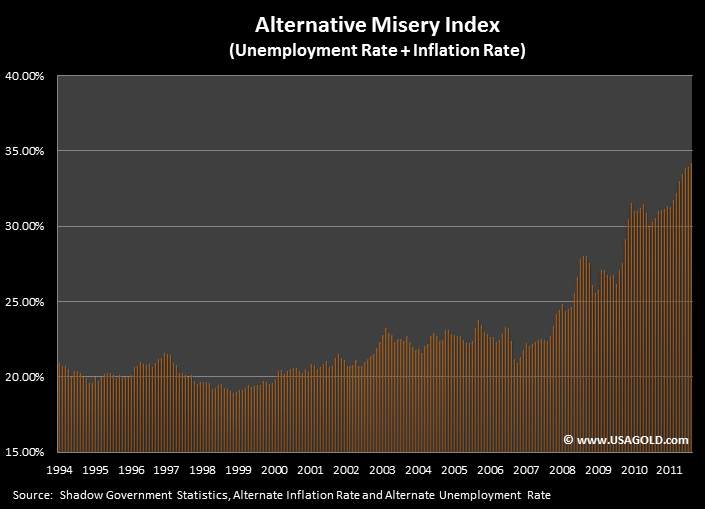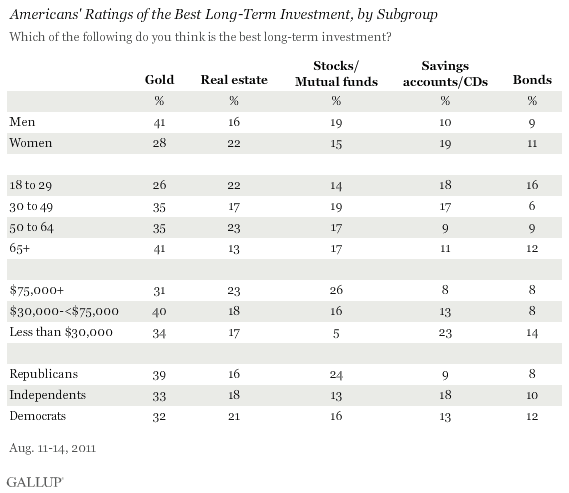Alternative Misery Index Drives Gold Demand
Commodities / Gold and Silver 2011 Oct 18, 2011 - 06:08 AM GMT Misery loves company, and particularly the company, comfort and security of gold. Since the financial breakdown of 2008, the Misery Index -- unemployment and inflation added together -- has been in a steep upward trajectory, so has the demand for gold coins and bullion.
Misery loves company, and particularly the company, comfort and security of gold. Since the financial breakdown of 2008, the Misery Index -- unemployment and inflation added together -- has been in a steep upward trajectory, so has the demand for gold coins and bullion.
The Misery Index was first popularized by Ronald Reagan in the 1980 presidential campaign. Reagan used it as a barometer for how well the country was doing economically. During Jimmy Carter's presidency the Misery Index hit an all-time high -- almost 22%. Near the end of Reagan's tenure in the White House, he had reduced the unemployment and inflation rates meaningfully -- to 7.7% by 1986. Barrack Obama's Misery Index now stands at almost 13% using federal government statistics and we all know things are getting worse not better. We also know that things might be quite a bit worse than what we are led to believe. That's where Shadow Government Statistics -- an alternative, and some say more realistic, rendition of economic statistics -- comes into the picture.
Many question the government's version of the consumer price and unemployment numbers saying they are politically motivated and reported on the low side to quell public discontent. Shadow Government Statistics (SGS) publishes its own version of the inflation and unemployment rates and its number are considerably different from the U.S. Department of Labor's version. SGS' inflation numbers reflect the same statistical methodology the DOL used in 1980. Its unemployment numbers use the same methodology the government used in 1994. (For details, please visit the Shadow Government Statistics website.) As you can see, if SGS stats are applied, the Obama administration's Alternative Misery Index would be around 34% -- far worse than the Carter administration's economic performance, and over 2.5 times worse than the numbers used by the federal government.

A recent Washington Post poll found 73% of Americans doubt Washington's ability to solve economic problems. In a certain sense, Americans have begun to take the matter into their own hands. Politically, the general discontent among Americans has manifested itself in the electoral successes of the Tea Party movement on the right, and on the left in the Occupy Wall Street movement that has recently captured headlines. Financially, that public concern has manifested itself in booming demand for gold coins and bullion -- a phenomena that transcends both the political spectrum and national borders. In fact, the Alternative Misery Index and the demand for gold coins have risen in tandem since 2008. (Please see the Gold Eagle Bullion Coin Sales chart below.)
Gallup Poll - Americans choose gold as the best long term investment
According to a surprising recent Gallup poll (shown above), Americans view gold as the best long term investment over real estate, stocks, bonds and savings accounts. "Gold," says Gallup, "is Americans' top pick as the best long-term investment regardless of gender, age, income, or party ID, but men, seniors, middle-income Americans, and Republicans are more enamored with it than are other Americans." 34% of those polled chose gold, 19% real estate, 17% stocks, 14% savings, 10% bonds. 41% of men rated it the best investment.
"That one in three Americans see gold as the best long-term investment," concludes Gallup,"may indicate a bubble in the value of this precious metal -- something that may be corroborated if gold continues to plunge as it did Wednesday. [Editor's note: It has in fact turned to the upside.] At the same time, this sentiment among many Americans may be related to the growing lack of confidence in the U.S. economy. This is particularly the case among upper-income Americans, who are now more pessimistic about the direction of the economy than their middle- and lower-income counterparts. The last time this happened was during the financial crisis of late 2008 and early 2009."
U.S. gold Eagle bullion coin sales, as shown in the chart below, are representative of the trend. Note the substantial growth from the time of the 2008 financial crisis forward. Note also that the growth is in number of ounces, not dollar volume. Bullion coin sales are seen generally by analysts as a proxy for the overall market.

Gold market amassing a boatload of potential energy
The number of people who actually own investment gold in the United States is miniscule when compared to those who own stocks -- no matter what the polls say. 34% of Americans say gold is the best long-term investment, but how many of that 34% actually own it in the form of coins and bullion? No one has that figure, but my guess would be less than 1% (of the total population) and I doubt I am all that far from the truth. Compare that with the number of people who own stocks -- 10% of the population reportedly owns 85% of the stocks.
Consider for a moment what might happen to the gold price and the supply of gold coins and bullion if, over the coming years, there was a steady progression toward 10% of the population becoming gold owners. When you consider that 34% of the population would like to own gold -- no matter their present circumstances -- and less than 1% actually owns it, you begin to understand why gold is not in a bubble at all, but in fact, in a long-term secular bull market that still amassing considerable potential energy.
In fact, it would be difficult to measure the effect of current gold owners doubling -- to let's say 2%, let alone to 10%. Let's not forget that the inflation-adjusted price of gold is about $2300 per ounce -- a figure which reflects past monetary growth without regard to a significant rise in physical demand. Blend in a doubling or tripling of global investment demand from current levels -- a distinct possibility -- and you paint a whole new picture for gold.
What do you tell your mother when she asks where to put her money?
In 2008, financial author Michael Lewis (Liars' Poker, The Big Short, et al) interviewed Kyle Bass, the legendary hedge fund operator who made a fortune betting against subprime mortgages. That interview triggered an inquiry that would ultimately become Lewis' latest book, Boomerang - Travels in the new third world.
In "Boomerang," Bass outlines a future debt crisis gone out of control. He predicts that Greece would become the first country to succumb to the crisis and eventually default -- just the first of many nation states and financial institutions to be caught up in a general European financial collapse.
This is the same Kyle Bass who persuaded the University of Texas to make a $1 billion investment in gold bullion -- about 5% of the funds total assets. "Central banks are printing more money than they ever have, so what's the value of money in terms of purchases of goods and services," Bass told Bloomberg at the time. "I look at gold as just another currency that they can't print any more of.
Here is an excerpt from that Bass interview as published in Lewis' Boomerang:
"What do you tell your mother when she asks you where to put her money?" I asked.
"Guns and gold," he said simply.
"Guns and gold," I said. So he was nuts.
"But not gold futures," he said, paying no attention to my thoughts. "You need physical gold." He explained that when the next crisis struck, the gold futures market was likely to seize up, as there were more outstanding futures contracts than available gold. People who thought they owned gold would find they owned pieces of paper instead. He opened his drawer, hauled out a giant gold brick and dropped it on the desk. "We bought a lot of this stuff."
For a free subscription to our newsletters, please click here.
By Michael J. Kosares
Michael J. Kosares , founder and president
USAGOLD - Centennial Precious Metals, DenverMichael Kosares has over 30 years experience in the gold business, and is the author of The ABCs of Gold Investing: How to Protect and Build Your Wealth with Gold, and numerous magazine and internet articles and essays. He is frequently interviewed in the financial press and is well-known for his on-going commentary on the gold market and its economic, political and financial underpinnings.
Disclaimer: Opinions expressed in commentary e do not constitute an offer to buy or sell, or the solicitation of an offer to buy or sell any precious metals product, nor should they be viewed in any way as investment advice or advice to buy, sell or hold. Centennial Precious Metals, Inc. recommends the purchase of physical precious metals for asset preservation purposes, not speculation. Utilization of these opinions for speculative purposes is neither suggested nor advised. Commentary is strictly for educational purposes, and as such USAGOLD - Centennial Precious Metals does not warrant or guarantee the accuracy, timeliness or completeness of the information found here.
© 2005-2022 http://www.MarketOracle.co.uk - The Market Oracle is a FREE Daily Financial Markets Analysis & Forecasting online publication.




